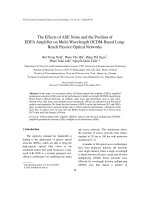The effects of teachers using authentic materials on reading comprehension and learning motivation of efl lower secondary students (tt)
Bạn đang xem bản rút gọn của tài liệu. Xem và tải ngay bản đầy đủ của tài liệu tại đây (1005.07 KB, 16 trang )
ABSTRACT
This research was conducted to investigate the effects of teacher’s using
authentic material on EFL lower secondary students’ reading comprehension. In
addition, the researcher also wanted to discover the effects of teacher’s using authentic
materials on EFL lower secondary students’ motivation. To find out the answers to the
two research questions, the researcher used authentic materials to teach reading skill in
class. An experimental mixed method was used to analyze and synthesize data which
was collected from a Pre- and Post- test paper and two phases of questionnaire
delivery. The results showed that authentic materials had a positive effect on EFL
lower secondary students’ reading comprehension and motivation. It helped students
improve their reading comprehension skill on learning English. It also engages
students in learning reading and helps to raise students’ confidence.
Key words: Authentic materials, reading comprehension, motivation.
iii
TABLE CONTENT
DECLARATION ……………………………………………………………………..i
ACKNOWLEDGEMENT …………………………………………………………..ii
ABSTRACT…………………………………………………………………………..iii
TABLE CONTENT………………………………………………………….……….iv
LIST OF TABLES…………………………………………………...…………...…vii
LIST OF FIGURES…………………………………………………………….......viii
CHAPTER ONE: INTRODUCTION……...………………………...………...........1
1.1 Rationale……………………………………………………………………...........1
1.2 Research aims…………………………………………………………………...…2
1.3 Research questions…………………………………………………………………3
1.4 Research hypothesis…………………………………………………………..……3
1.5 Significant of the study……………………………………………………..……...3
1.6 The structure of the study………………………………………………………….4
CHAPTER TWO: LITERATURE REVIEW……………...………………….……5
2.1 Reading .....................................................................................................................5
2.2 Authentic materials....................................................................................................7
2.2.1 Authentic texts……………………………………………………………………9
2.2.2 Authentic tasks…………………………………………………………………...9
2.3 Motivation...............................................................................................................10
2.3.1 Definition of motivation………………………………………………….....…10
2.3.2 Types of motivation in Second Language Learning…………………………..11
2.4 Learners’
reading
comprehension
ability
in
relations
to
authentic
materials……….……………………………………………………………………...12
2.4.1 Reading comprehension ability in relations to visual aids…………....….……12
2.4.2 Reading comprehension ability in relations to authentic text…………………13
2.5 Reading motivation and in relations to authentic materials………………….…..14
2.5.1 Reading motivation in relations to visual aids…………...……………………14
2.5.2 Reading motivation in relations to authentic text………………..…………….14
2.6 Related studies………………….…………………………………………...……15
CHAPTER THREE: RESEARCH METHODOLOGY………………………..…21
iv
3.1 Research design…………………………………………………………………..21
3.2 Course specifications………………………………………………………..……22
3.3 Participants………………………………………………………………………..23
3.4 Research instruments……………………………………………………………..24
3.4.1 Pre-test and post- test paper……….……………………………………...........25
3.4.2 Questionnaires………………………………………………………….….......25
3.4.3 Interviews……………………………………………………………………...26
3.5 Materials…………………………………………………………………...……..26
3.6 Data collection procedures..………………………………………………………27
3.6.1 Administering test…………………………………………………………..…..28
3.6.2 Administering questionnaire………………………………………………..…..28
3.6.3 Administering interview………………..…..…………………………………29
3.7 Measurement……………………………………………………………..….......30
3.7.1 Learners’ reading comprehension ability……………………………………..30
3.7.2 Learners’ motivation………………………………..…………………………..30
CHAPTER FOUR: RESEARCH FINDINGS……………………………………..31
4.1 Effects of authentic materials on reading comprehension of EFL lower secondary
students……………………………………………………………………………31
4.2 Effects of authentic materials on reading motivation of EFL lower secondary
students……………………………………………………………………………34
CHAPTER FIVE: CONCLUSION AND DISCUSSION…………...………….…40
5.1 Summary of findings………………………………………………………………40
5.1.1 Teacher’s using authentic materials on reading comprehension of EFL lower
secondary students…………………………………………………………………40
5.1.2
Teacher’s using authentic materials on reading motivation of EFL lower
secondary students…………………………………………………………………41
5.2 Implication and suggestion……………………………………………………….42
5.3 Limitation of the study……………………………………………………………42
5.4. Conclusion…………………………………………………………………….…42
REFERENCE……………………………………………………………….……..…44
APPENDIX 1:Questionnaire……………………………………………….………….1
v
APPENDIX 2: Transcription of individual interview.................................……………5
APPENDIX 3. Tests………………………………………………………………......10
APPENDIX 3: Raw calculation test…………………………………………………..19
vi
LIST OF TABLES
Table 3.1: Course program……………………………………………………………23
Table 3.2: Research procedures……………………………………………………… 28
Table 3.3: Research design……………………………………………………………29
Table 3.4: The interviewees’ personal information…………………………………...30
Table 4.1: Descriptive statistic of participants’ reading comprehension ability…...…33
Table 4.2: Mean scores of Control group and Experimental group 1 on Preintervention……………………………………………………………………………33
Table 4.3: Mean scores of Control group and Experimental group 2 on Preintervention……………………………………………………………………………33
Table 4.4: Descriptive statistics on Pre- and Post- intervention of the three groups
(Tests)...……………………………………………………………………………….35
Table 4.5: Descriptive statistics on Pre- and Post- intervention of the three groups
(Questionnaire)………………………………………………………………………..37
Table 4.6: Students’ motivation in reading…………………………………………...38
Table 4.7: Students’ attitude toward the reading texts, pictures and tasks……………38
vii
LIST OF FIGURES
Figure 1. The number of male and female participants……………………………….24
Figure 2. Mean scores of the three groups in Pre- intervention……………………....34
Figure 3. Comparision between Pre-test and Post-test of the three groups…..………36
viii
CHAPTER ONE
INTRODUCTION
The first chapter includes five main sections. The rationale of the research
presents the current picture of teaching and learning English in EFL context. It leads
to reasons for conducting the present study. The next parts are related to research
aims, research questions, significance and structures of the thesis.
1.1 RATIONALE
Teaching and learning English has been becoming extremely popular in Vietnam
today. Playing an important role in Vietnam education, English is considered as a
compulsory subject, together with Math, Physics, Chemistry, Literature; without
English students can not complete their lower secondary education. In particular,
Prime Minister has announced Decision No. 1400/QĐ-TTg “Teaching and Learning
Foreign Languages in the National Education System, Period 2008 to 2020” to
enhance English language teaching and learning in Vietnam in all school levels. The
general goal of this project is:
“by the year 2020 most Vietnamese youth whoever graduate from vocational
schools, colleges and universities gain the capacity to use a foreign language
independently. This will enable them to be more confident in communication, further
their chance to study and work in an integrated and multi-cultural environment with
variety of languages. This goal also makes language as an advantage for Vietnamese
people, serving the cause of industrialization and modernization for the country”
(MOET, 2008).
In addition, it is now a main concern of everyone from parents to students to school
administrators. Educators in general and teachers in particular always try to make
innovations to improve the quality of teaching and learning English. However, it is
really hard to admit a reality that students can not use English as a mean of
communication in their real life although they easily pass their examinations at school.
There is a gap between what is expected from EFL students and what they are
performing at school. In my place, I focus on learners’ reading comprehension skill in
1
which learners can only answer some simple questions or comprehend some simple
text. One of the most prominent factors that influence students’ reading skill is the
series of coursebook from grade three to grade twelve, and mainly used as the primary
source for teaching and learning English in public secondary system in Vietnam.
Within the scope of the thesis I mainly focus on the course book used for grade
seventh, the level that I have been teaching for 6 years. What take my concern is
authenticity in the course book content and texts is almost ignored. The pictures in the
reading session of the course book are not real and suitable enough to attract students’
interest and the texts designed are not related to the real life. In addition, one challenge
for the teachers in charge is the curriculum designed by MOET in terms of teaching
time and learning activities. Furthermore, the detailed syllabus is designed by the
department of education and training of Ben Tre province; therefore, there is no space
for the teachers’ intervention and adjustability. The things are fixed and based on the
course book.
In contrast, the use of authentic materials in an EFL classroom has recently been
discussed by many researchers in foreign language teaching. According to Harmer
(1994), authentic materials help language learners to become better readers and
learners with the ability to produce good language. Authentic materials also help
language acquisition process be better and faster. In addition, students feel satisfied
over their achievement in the proficiency of the language because the skills they gain
make them feel that they can face the situations in their real life too.
Furthermore, authentic materials help to motivate learners to learn the language by
exposing the 'real' language to them (Guariento & Morely, 2001). Hyland (2003)
stated that authentic materials help increase learners’ motivation and reflect on their
learning process positively. Learners were encouraged to learn a particular language
successfully with the help of authentic materials because they notice they are dealing
with the language in real life (Azri & Majid, 2014). Therefore the English presented in
the classroom should be authentic; not produced only for instructional purpose. In the
story, I will focus first on examining the effects of using authentic materials on reading
comprehension ability and motivation of EFL lower secondary students, aged 12. It is
expected that the findings of the research will contribute to increasing EFL lower
2
secondary students’ reading comprehension and motivation in learning language,
English.
1.2 RESEARCH AIMS
This study is conducted to:
-
Investigate the effect of teachers’ using authentic materials on reading
comprehension of EFL lower secondary student.
-
Investigate the effect of teachers’ using authentic materials on reading
motivation of EFL lower secondary student.
1.3 RESEARCH QUESTIONS
Two major research questions were carefully investigated:
1. What is the effect of teacher’s using authentic materials on reading
comprehension of EFL lower secondary students?
2. What is the effect of teacher’s using authentic materials on reading motivation
of EFL lower secondary students?
1.4 RESEARCH HYPOTHESES
Relying on research aims and research questions, the following hypotheses are
formed:
1. Authentic materials help EFL lower secondary students develop their reading
comprehension.
2. Authentic materials motivate EFL lower secondary students on learning
English, particularly reading skill.
1.5 SIGNIFICANCE OF THE STUDY
Reading is considered one of the most important skills that EFL students need to
acquire (Levine, 2010). Reading is significant in developing language intuition and
determining academic success and completing certain task. However, acquiring
reading skill requires one to be able to comprehend the text itself. Whereas authentic
materials offer significant benefits for the improvement of teaching and learning
3
especially for learning reading skills. Nunan (1995, p. 216) mentions that authentic
materials have an important advantage in teaching-learning processes. He claims that
using authentic materials at beginner classes will give the students exposure before
they meet real world language used outside the classroom. In addition, Nuttall (1996,
p. 172) states that “authentic texts can be motivating because they are proof that the
language is used for real life purposes by real people”. Guariento and Morley (2001)
stated that authentic materials is very important in learning since it increases students'
motivation for learning, makes the learner be exposed to the 'real' language. Bacon and
Finneman (1990) showed that authentic materials provide an appropriate context to
relate form to meaning in the language acquisition process ( p.459).
However, in Ben Tre province, research relating to authentic materials for young
learners was rarely conducted, especially research on the effects of using authentic
materials on reading comprehension ability and motivation of EFL grade seventh
students. In addition, people in general complaint that students can not apply the
language they have learned in their real life although they can pass the course exam. It
is expected that the finding of this study will help the learners as well as the language
teachers to perceive better about the effectiveness of using authentic materials on
students’ reading comprehension ability and motivation. As a result, this study will be
a future guideline for the English language teachers regarding the issue.
1.6 THE STRUCTURE OF THE STUDY
The thesis consists of five chapters: Introduction, Literature Review, Research
Methodology, Research Findings, Discussion and Conclusion.
Chapter One presents chapter one presents the rationale, research aims, research
questions and hypotheses. It also comprises significance and the structure of the study.
Chapter Two reviews literature related to using authentic material including
reviews theoretical background that is necessary for conducting the research. There are
two parts in this chapter; the first part states the definitions of terminologies used in
the research and the second one reviews some related studies
4
Chapter Three describes whole picture of research methodology including design
of study, participants, measurements, course specifications, data collection and
analysis and reliability of research instruments.
Chapter Four reports the results from the data collected through the use of tests,
questionnaires and interview.
Chapter Five presents the summary of the major research findings and the
discussion. Moreover, the limitations of the study as well as implications and
suggestion for further research are recommended at the end of the chapter.
5
REFERENCE
1) Aftab, A., & Salahuddin, A. (2015). Authentic Texts and Pakistani Learners’
ESL Reading Comprehension Skills: A Mixed-Method Study. Language
Education in Asia , 6 (2), 122-134.
2) Aguiar, L., & Bradi, S. (1991). Vocabulary acquisition and reading ability.
Reading and Writing: An interdisciplinary Journal, 3, 413- 425.
3) Apsari, Y. (2014). The use of authentic materials in teaching reading
comprehension. ELTIN Journal, Volume 2/II.
4) Azri, R. H., & Rashdi, M. (2014). The effects of using authentic materials in
teaching. International journal of scientific & technology research, Vol. 3,
Issue. 10.
5) Baniabdelrahman, A. (2006). The effect of using authentic English language
matearials on EFL students' achievement i reading comprehension. Journal of
education and Psychological sciences, 8-12.
6) Berardo, S. A. (2006). The use of authentic materials in the teaching of reading.
The Reading Matrix, Vol. 6, No. 2.
7) Canh, L. V. (2001). Language and Vietnamese pedagogical contexts. Teacher's
edition.
8) Chavez, M. M. (1998). Learners' perspectives on athenticity. IRAL, 36(4),
pp.277-306.
9) Chen, H. T. (1997). Applying mixed methods under the framework of theorydriven evaluation. New direction for evaluation, 61-72.
10) Davenport, T. R. (2007). Mastering the critical reading test. Canada: Wiley,
Hoboken, NJ.
11) Deci, E. L. (1975). Intrinsic motivation. New York: Plenum.
12) Deci, E. L., & Ryan, R. (1985). Intrinsic motivation and self- determination in
human bahavior. New York: Plenum.
13) Deci, E. L., & Ryan, R. (2000). Intrinsic and extrinsic motivations: Classic
definitions and new directions. Contemporary Educational Psychology , 25, 5467.
46
14) Deci, E. L., Koestner, R., & Ryan, R. M. (1998). Extrinsic rewards and intrinsic
motivation: Clear and reliable effects. Unpublished manuscript, University of
Rochester.
15) Deci, E. L., Nezlek, J., & Sheinman, L. (1981). Characteristics of the rewarder
and intrinsic motivation of the rewardee. Journal of personality and social
psychology, 40, 1-10.
16) Dickinson, L. (1995). Autonomy and motivation in literature review.
Pergamon, Vol. 23. No. 2, pp 165-174.
17) Dörnyei, Z. (1994). Motivation and motivating in the foriegn language
classroom. The Modern Language Journal , Vol. 78, No. 3, pp. 273-284 .
18) Dörnyei, Z. (1998). Motivation in second and foreign language learning .
Language Teaching, Volume. 31, Issue. 03, pp 117 - 135 .
19) Dörnyei, Z. (2001). Motivational strategies in the language classroom.
Cambridge: Cambridge University Press.
20) Gardner, R. C., & Lambert, W. (1972). Attitude and Motivation in second
language learning.
21) Gilmore, A. (2007). Authentic materials and authenticity in foreign language
learning. Cambridge University Press , 40, 97-118.
22) Golkar, M., & Yamini, M. (2007). Vocabulary, proficiency, and reading
comprehension. The Reading Matrix, 7(3), 88-112.
23) Guariento, W., & Morley, J. (2001). Text and task authenticity in the EFL
classroom. ELT Journal, 55(4), 347-353.
24) Guo, S. (2012). Using Authentic Materials for Extensive Reading to Promote
English Proficiency . English Language Teaching, Vol. 5, No. 8.
25) Heitler, D. (2005). Teaching with authentic materials. Pearson Education.
26) House, S. (2008). Authentic materials in the classroom. Salamanca editions.
Universidad de Salamanca
27) Khaki, N. (2014). Improving Reading Comprehension in a Foreign Language:
Strategic Reader . The Reading Matrix, Vol. 14, No. 2.
28) Lee, W. Y. ( October 1995). Authenticity revisited: text authenticity and learner
authenticity. ELT Journal, Vol. 49, Issue. 4, pp. 323–328.
47
29) Macwan, H. J. (2015). Using visual aids as authentic materials in ESL
classrooms. Research Journal of English language and literature (RJELAL),
Vol. 3, Issue.1.
30) Martinez, A. (2002). Authentic materials: An overview. Free resources for
teachers and students of English. Karen's Linguistics Issues, 1-7.
31) Marzban, A. (2015). The effects of authentic texts on motivation and reading
comprehension of EFL students at intermediate level of proficiency.
Department of English language, Islamic Azad university.
32) Mckee, S. (2012). Reading Comprehension, What We Know: A Review of
Research 1995 to 2011 . Language Testing in Asia , Vol. 2, Issue. 1.
33) Melor, M. D., & Yunus, H. (2013). Using visual aids as a motivational tool in
enhancing students' interest in reading literary texts. Faculty of education
university Kebangsaan Malaysia.
34) Melvin, B. S., & Stout, D. (1987). Motivating language learners through
authentic materials. Cambridge university press, 44-56.
35) Moore, P. J., & Scevak, J. (1997). Learning from texts and visual aids: a
developmental perspective. Journal of research in reading, Volume 20, Issue 3,
pp 205-223.
36) Nuttall, C., & Heinemann. (1996). Teaching reading skills in a foreign language
( New edition). Oxford, 282.
37) Parmawati, A., & Parmawati , R. (2017). Using authentic material to improve
students’ reading interest . ELTIN Journal, Vol 5/1.
38) Peacock, M. (1997). The effects of authentic materials on the motivation of
EFL learners. English language teaching journal, 51, pp2.
39) Perfetti, C. (2007). Reading Ability: Lexical Quality to Comprehension .
Scientific Studies of Reading , 11:4, 357-383.
40) Polio, C. (2014). Using authentic materials in the beginning language classroom
. Michigan State University, Vol. 18, Issue. 1.
41) Rasinski, T., Homan, S., & Biggs, M. (2009). Teaching Reading Fluency to
Struggling Readers: Method, Materials, and Evidence. Reading & Writing
Quarterly, 25,192–204.
48
42) Ryan, E. M., & Deci, E. L. (2000). Intrinsic and Extrinsic Motivations: Classic
Definitions and New Directions. Contemporary Educational Psychology , 25,
54–67.
43) Ryan, R. M., & Deci, E. (2000). Self-Determination Theory and the Facilitation
of Intrinsic Motivation, Social Development, and Well-Being. American
Psychologist , Vol. 55, No. 1, 68-78.
44) Sample, M. G. (2015). Authentic materials: A motivational tool for the EFL
classroom? Eduacation and Linguistics Research , Vol. 1, No. 2.
45) Senior, R. (2005). Authentic response to authentic materials. English teaching
professional, 38, 71.
46) Shaikholeslami, R., & Khayyer , M. (2006). Intrinsic motivation, extrinsic
motivation, and learning english as a foreign language. Psychological Reports,
99, 813- 818.
47) Sutarsyah, C. (2013). Reading theory and practice. Bandar Lampung: Lembaga
Penelitian Universitas Lampung.
48) Tadros, L. (2014). Definition and Approaches to measuring reading
proficiency. Cello Fact Fact Journal, Vo. 2.
49) Tamo, D. (2009). The use of authentic materials in classrooms . Article 9 in
LCPJ , Vol 2/1.
50) Ugaide, A. R. (2008). Using authentic materials to teach reading
comprehension. Letras, pp 75-92.
51) Wallace, C. (1992). Reading. Oxford, O.U.P.
52) White, R. W. (1959). Motivation reconsidered: the concept of competence.
Psychological review, Vol. 66, No. 5.
53) Whittaker, S. G., & Kichint, J. (1993). Visual requirements for reading.
Optometry & vision science, Vol. 70, No. 1, pp. 54- 65.
54) Widdowson, H. G. (1996). Comment: Authenticity and autonomy in ELT. ELT
Journal, 50(1), 67-68.
55) Widdowson, H. G. (1998). Context, community, and authentic materials.
TESOL Quarterly, 32(4), 705-715.
49
56) Woolley, G. (2011). Reading Comprehension: Assisting Children with
Learning Difficulties. Springer Science +Business Media B.V. .
57) Yasrida, N. (2017). Using authentic material in reading comprehension of
students’ low and high proficiency levels at sman 3 Bandar Lampung .
Lampung University Bandar Lampung .
50

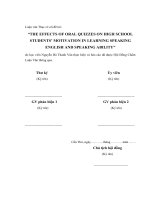
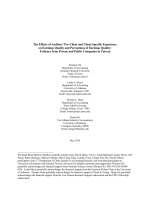
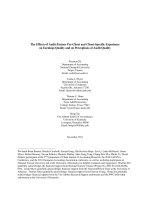
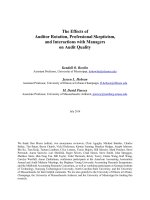
![daniels and booker - 2011 - the effects of audit firm rotation on perceived auditor independence and audit quality [mafr]](https://media.store123doc.com/images/document/2015_01/06/medium_sds1420548148.jpg)


